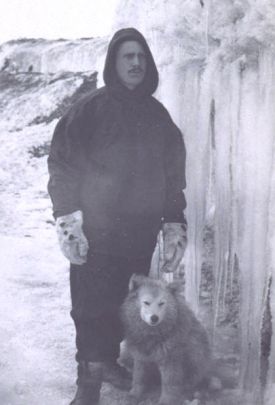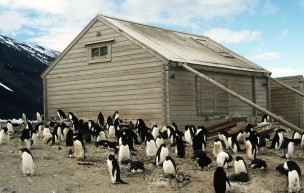Heroic Age Antarctic Veteran

Very few people have heard of Louis Bernacchi and yet he was the first person to have spent two winters in Antarctica on major expeditions.
Louis migrated to Tasmania from Belgium with his family when he was seven years old and settled on Maria Island on the east coast of Tasmania.
By 1895 he began his training in astronomy and magnetic studies at Melbourne Observatory which would lead to his adventures in Antarctica.
His training made him suitable for the role of physicist when expeditions came looking for qualified personnel and due to this he was supposed to join Adrien de Gerlache’s Belgian Antarctic Expedition (Belgica) at Melbourne in March 1898 but de Gerlache’s ship became trapped in ice and never made it to Melbourne.
Luckily Carsten Borchgrevink had acquired funding for his ‘Southern Cross’ expedition (1898-1900) and Louis signed on as physical scientist and photographer.
The expedition landed at Cape Adare in Antarctica and built two huts where they would become the first people to overwinter on the Antarctic mainland, while Louis carried out an extensive scientific programme.
Borchgrevink, though somewhat inspired, brave and motivated, was also an incredibly difficult personality, bordering on madness at times, and the stay in Antarctica was uncomfortable for all concerned.
Louis’ diary paints a rather negative portrait of Borchgrevink but to his credit Borchgrevink did manage to organise an expedition without government help and they managed a number of firsts 1) first to overwinter, 2) first to use dogs, 3) first to dogsled towards the South Pole 4) first building in Antarctica

As the expert photographer on the expedition Louis took many images of the expedition which are now archived in the Norwegian Polar Institute (Norsk Polarinstitutt-NPI).
After this Antarctic adventure Bernacchi returned to England with the Southern Cross, wrote and published his book, ‘To the south polar regions: expedition of 1898-1900’ in 1900.
He maintained a long involvement with the various institutions devoted to polar science and Antarctica such as the Royal Geographical Society, the British Association and the Antarctic Club and kept in touch with his shipmates, other Antarcticans and scientists.
After his return to England, Louis was almost immediately recruited for Scott’s Discovery expedition (1901-04) and was placed in charge of the terrestrial magnetism programme as well as seismology, gravity determinations, auroral observations, astronomy and electrostatic measurements .
During the second winter Bernacchi edited the South Polar Times and would later contribute significantly to the expedition’s official reports on physical science.
In 1938, long after the expedition, he would go on to publish ‘Saga of the Discovery’ (an excellent book) that chronicled the working history of the famous ship.
The book also covers his experience on the 1901–1904 expedition. Bernacchi did not return to Antarctica after the Discovery expedition although he did maintain an ongoing interest in Antarctic science and expeditions throughout his life.
After Antarctica, Bernacchi travelled extensively to Africa, South America and South-East Asia to develop his interest in rubber plantations. He finally settled in England and married Winifred Harris in 1906 with Captain Robert Falcon Scott as his best man.
Scott tried to recruit him for his ill-fated second Antarctic expedition (1910-13) but he declined due to family responsibilities.
Bernacchi also twice unsuccessfully stood for parliament as a Liberal candidate. He was a member of various clubs, enjoyed the sport of fencing, and travelled extensively. In spite of constant financial worries, Louis managed to live a life of gentlemanly leisure on the profits from his rubber plantations.
Louis served as a patrol boat commander in the Royal Naval Volunteer Reserve during World War I and intended to organise and lead his own Antarctic expedition in 1925 but a lack of financial support ended the venture.
Bernacchi did however organise the initial development of tracked vehicles, which were successfully trialled in 1925 and he also organised the 1930 British Polar Expedition.
In Antarctica various landforms are named for him including Bernacchi Head on Franklin Island, and Cape Bernacchi and Bernacchi Bay on the coast of Victoria Land. A species of Antarctic fish, the Trematomus bernacchii was also named in his honour. There is also a memorial statue of him in Hobart.

Bernacchi slipped out of public view after the reports from the Discovery expedition were finally published and he died in 1942.
His granddaughter Janet Crawford has edited a version of his diaries from the expedition under the title ‘The First Antarctic Winter: The story of the Southern Cross Expedition of 1898-1900’ (another excellent book)
Louis Bernacchi was an unsung hero of polar exploration. Thank you Louis for your service to exploration and scientific discovery.
